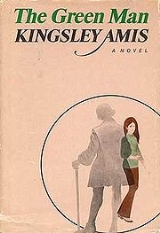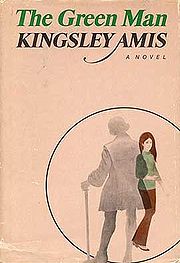
The Green Man
Encyclopedia

Kingsley Amis
Sir Kingsley William Amis, CBE was an English novelist, poet, critic, and teacher. He wrote more than 20 novels, six volumes of poetry, a memoir, various short stories, radio and television scripts, along with works of social and literary criticism...
. A Times Literary supplement reviewer described The Green Man as “three genres of novel in one”: ghost story, moral fable, and comic novel. The novel reflects Amis’s willingness to experiment with genre novels (e.g., The Alteration
The Alteration
The Alteration is a 1976 alternate history novel by Kingsley Amis, set in a parallel universe in which the Reformation did not take place. It won the John W. Campbell Memorial Award in 1977.-Creative origins:...
(science fiction/alternate history), or Colonel Sun: a James Bond Adventure
Colonel Sun
Colonel Sun , by Kingsley Amis, is the first James Bond continuation novel published after Ian Fleming's death in 1964; Glidrose Productions used the collective pseudonym "Robert Markham", for British novelist Kingsley Amis, with the intent of so publishing other novels by different writers...
) while displaying many of the characteristics of his conventional novels, both in superficial aspects such as fogeyishness and problems with alcohol, and in more substantive aspects such as a self-reflective observation of human cruelty and selfishness in everyday relations.
Setting
The novel is set in and around The Green Man, an inn between LondonLondon
London is the capital city of :England and the :United Kingdom, the largest metropolitan area in the United Kingdom, and the largest urban zone in the European Union by most measures. Located on the River Thames, London has been a major settlement for two millennia, its history going back to its...
and Cambridge
Cambridge
The city of Cambridge is a university town and the administrative centre of the county of Cambridgeshire, England. It lies in East Anglia about north of London. Cambridge is at the heart of the high-technology centre known as Silicon Fen – a play on Silicon Valley and the fens surrounding the...
owned by Maurice Allington, a 53 year old man with a second wife, a teenage daughter and an 80 year old father living with him in the inn’s upstairs apartment. The inn and its name date back to the 14th century, and the inn’s charm is further embellished by a history of haunting related to a 17th century owner, Thomas Underhill, a Cambridge
University of Cambridge
The University of Cambridge is a public research university located in Cambridge, United Kingdom. It is the second-oldest university in both the United Kingdom and the English-speaking world , and the seventh-oldest globally...
scholar who dabbled in the occult. Underhill was associated with two unsolved murders, including that of his wife, which could not be traced back to him.
Plot
As the novel unfolds, Allington is beset by a number of difficulties, including his father’s death by stroke at dinner one night, and a drinking problem that causes hypnagogicHypnagogia
Hypnagogia is the transitional state between wakefulness and sleep , originally coined in adjectival form as "hypnagogic" by Alfred Maury....
jactitation
Jactitation
-Legal jactitation:In English law, jactitation is the maliciously boasting or giving out by one party that he or she is married to the other.In such a case, in order to prevent the common reputation of their marriage that might ensue, the procedure is by suit of jactitation of marriage, in which...
and hallucinations; Maurice compounds his problems by pursuing an affair with his doctor’s wife, neglecting his daughter Amy, whose mother, Maurice’s first wife, was run down in an automobile accident, and attempting to seduce both his current wife and his mistress into a menage a trois
Ménage à trois
Ménage à trois is a French term which originally described a domestic arrangement in which three people having sexual relations occupy the same household – the phrase literally translates as "household of three"...
, which backfires when the two women take an enthusiastic interest in each other and effectively shut him out of the orgy.
During this time Maurice begins to see ghosts around the inn – a red-haired woman, presumably Underhill’s wife, in the hallway, a small bird floating above his bathtub, the specter of Thomas Underhill himself in the dining room – and yet has a difficult time communicating this to his family and friends, who assume that heavy drinking and the stress of his father’s death are causing him to hallucinate. Maurice’s own investigations take him to All Saints’ College, a fictional Cambridge
University of Cambridge
The University of Cambridge is a public research university located in Cambridge, United Kingdom. It is the second-oldest university in both the United Kingdom and the English-speaking world , and the seventh-oldest globally...
college (modeled on All Souls’
All Souls College, Oxford
The Warden and the College of the Souls of all Faithful People deceased in the University of Oxford or All Souls College is one of the constituent colleges of the University of Oxford in England....
of Oxford
University of Oxford
The University of Oxford is a university located in Oxford, United Kingdom. It is the second-oldest surviving university in the world and the oldest in the English-speaking world. Although its exact date of foundation is unclear, there is evidence of teaching as far back as 1096...
) of which Underhill was a fellow, and at which his papers are secreted. There he sees Underhill’s own record of having used his black arts to entice and then ravish young girls from the village.
In the meantime Maurice has discovered his own notes of a drunken, and forgotten, midnight conversation with Underhill, during which Underhill begins to enlist Maurice’s help in his as yet undisclosed scheme. This involves Maurice’s unearthing of Underhill’s nearby grave, in which he finds a pre-Columbian
Pre-Columbian
The pre-Columbian era incorporates all period subdivisions in the history and prehistory of the Americas before the appearance of significant European influences on the American continents, spanning the time of the original settlement in the Upper Paleolithic period to European colonization during...
figurine of silver that Underhill requests be brought to another midnight meeting in the inn’s dining room.
That afternoon, having left the scene of the failed orgy, Maurice finds himself in a strange time warp, as it were, in which all molecular motion outside of his drawing room ceases. He finds himself in the presence of a young, suave man who it comes to be understood is God himself. The purpose of the visit is to warn Maurice against Underhill and ask him to aid in Underhill’s destruction, but during the conversation Amis has the young man elaborate an interesting sort of theology, explaining the Creation and God’s powers within it. The young man leaves Maurice with a silver crucifix, as a sort of counter-weight to the silver figurine.
When the midnight meeting comes about, Underhill attempts to delight Maurice with a sort of holographic, yet primitive pornography show; Maurice feels himself as in damp, murky cave, on the walls of which are projected bizarre sexual scenes. As the show becomes more terrifying, Maurice realizes that Underhill has absented himself; when he hears his daughter crying out from the road in front of the inn, he realizes Underhill’s intentions. In the climactic scene, Maurice uses the crucifix to stun Underhill and runs outside, where he confronts the entity Underhill had used the figurine to conjure: the green man, a collocation of branches, twigs and leaves in the form of a large and powerful man. The thing is bent, evidently, on killing Maurice’s daughter Amy. By hurling the figurine back within the graveyard Maurice saps Underhill’s power and destroys the green man. Underhill’s purpose had been, apparently, to have Amy killed as a sort of experiment in lieu of the sexual depredations which are now forbidden him by his lack of corporeality.
A final scene wraps up the novel’s loose ends: Maurice destroys the figurine, and he employs the modish, cynical and repellent parish priest (who makes God out to be, in the young man’s words, a “suburban Mao Tse-tung”) to exorcise Underhill and his green man. Maurice’s wife leaves him (for his mistress), but his daughter proposes, and he agrees to, a plan to move away from The Green Man and get a fresh start. Maurice is somewhat relieved, while recognizing that he will remain until his death trapped in all of the faults, petty and otherwise, that constitute him as Maurice Allington.
Analysis
The novel is in one sense slight – an enjoyable ghost story laced with the sort of witty and crusty obiter dicta common in Amis novels – and yet it constitutes a more than negligible statement about personality, purpose and ethics in the late-20th century world of its setting. Thomas Underhill’s lust for pubescent girls still dominates him after three centuries of extra-corporeal existence – his mastery of the black arts and his circumvention of death have not released him from his banal perversions. Thus Maurice sees something of Underhill in himself when his wife throws up his orchestration of the orgy as just a way of “experimenting” with other people, just as Underhill intended to experiment on Amy, and looks forward, as the novel closes, to the release from his personality that death will bring him. It is not a stretch to see in this Amis’s view of the baby-boomer generation, with its proclivity for “experimental lifestyles” of all sorts that mainly take account only of the individual conducting the experiment (well-represented in the novel by the pseudo-radical priest Tom Rodney Sonnenschein). Indeed, God, as the young man, is seen in the novel as being a sort of experimenter Himself, which earns Him more than a whiff of Amis’s contempt.Ultimately, even Underhill’s desperate offer, as Maurice has him exorcised, to grant him peace of mind – “I imagined myself not noticing myself for the rest of my life, losing myself, not vainly struggling to lose myself, in poetry and sculpture and my job and other people, not womanizing, not drinking” (242) – cannot tempt Maurice to allow Underhill to go on threatening the young and helpless. And yet, even then, Maurice must wonder about his attachment to himself, with all his vices: “I have often wondered since whether what made up my mind for me was not the unacceptability of the offer as such, whether we are not all so firmly attached, in all senses, to what we are that any radical change, however unarguably for the better, is bound to seem a kind of self-destruction. I shook my head.” (242).
TV adaptation
The Green Man is a BBCBBC
The British Broadcasting Corporation is a British public service broadcaster. Its headquarters is at Broadcasting House in the City of Westminster, London. It is the largest broadcaster in the world, with about 23,000 staff...
three part TV serial which aired in 1990, starring Albert Finney
Albert Finney
Albert Finney is an English actor. He achieved prominence in films in the early 1960s, and has maintained a successful career in theatre, film and television....
.
The series won the 1991 BAFTA for Best Original Television Music (by Tim Souster
Tim Souster
Tim Souster was a British composer best known for his electronic music output.- Background :Born Timothy Andrew James Souster in Bletchley, Buckinghamshire, Souster was educated at Bedford Modern School and New College, Oxford...
), Finney was nominated for Best Actor, and Masahiro Hirakubo was nominated for Best Film Editor.
According to various sources http://www.south-central-media.co.uk/report.htmhttp://www.south-central-media.co.uk/chrono_list.htmhttp://www.bbc.co.uk/dorset/content/articles/2004/11/23/film_locations_feature.shtml, the serial was filmed on location with West Dorset doubling as the Cambridgeshire area and Up Cerne Manor House (and possibly Dominey's Yard by Buckland Newton) representing The Green Man hotel and other exteriors http://www.geograph.org.uk/photo/838535

